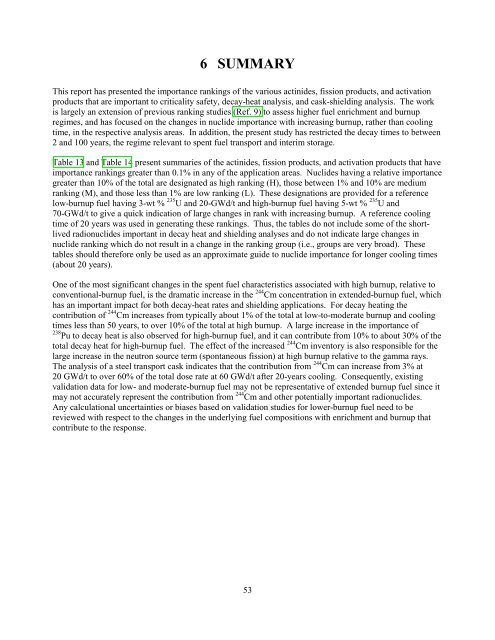nureg/cr-6700 - Oak Ridge National Laboratory
nureg/cr-6700 - Oak Ridge National Laboratory
nureg/cr-6700 - Oak Ridge National Laboratory
You also want an ePaper? Increase the reach of your titles
YUMPU automatically turns print PDFs into web optimized ePapers that Google loves.
Section 6<br />
Summary<br />
6 SUMMARY<br />
This report has presented the importance rankings of the various actinides, fission products, and activation<br />
products that are important to <strong>cr</strong>iticality safety, decay-heat analysis, and cask-shielding analysis. The work<br />
is largely an extension of previous ranking studies (Ref. 9) to assess higher fuel enrichment and burnup<br />
regimes, and has focused on the changes in nuclide importance with in<strong>cr</strong>easing burnup, rather than cooling<br />
time, in the respective analysis areas. In addition, the present study has restricted the decay times to between<br />
2 and 100 years, the regime relevant to spent fuel transport and interim storage.<br />
Table 13 and Table 14 present summaries of the actinides, fission products, and activation products that have<br />
importance rankings greater than 0.1% in any of the application areas. Nuclides having a relative importance<br />
greater than 10% of the total are designated as high ranking (H), those between 1% and 10% are medium<br />
ranking (M), and those less than 1% are low ranking (L). These designations are provided for a reference<br />
low-burnup fuel having 3-wt % 235 U and 20-GWd/t and high-burnup fuel having 5-wt % 235 U and<br />
70-GWd/t to give a quick indication of large changes in rank with in<strong>cr</strong>easing burnup. A reference cooling<br />
time of 20 years was used in generating these rankings. Thus, the tables do not include some of the shortlived<br />
radionuclides important in decay heat and shielding analyses and do not indicate large changes in<br />
nuclide ranking which do not result in a change in the ranking group (i.e., groups are very broad). These<br />
tables should therefore only be used as an approximate guide to nuclide importance for longer cooling times<br />
(about 20 years).<br />
One of the most significant changes in the spent fuel characteristics associated with high burnup, relative to<br />
conventional-burnup fuel, is the dramatic in<strong>cr</strong>ease in the 244 Cm concentration in extended-burnup fuel, which<br />
has an important impact for both decay-heat rates and shielding applications. For decay heating the<br />
contribution of 244 Cm in<strong>cr</strong>eases from typically about 1% of the total at low-to-moderate burnup and cooling<br />
times less than 50 years, to over 10% of the total at high burnup. A large in<strong>cr</strong>ease in the importance of<br />
238 Pu to decay heat is also observed for high-burnup fuel, and it can contribute from 10% to about 30% of the<br />
total decay heat for high-burnup fuel. The effect of the in<strong>cr</strong>eased 244 Cm inventory is also responsible for the<br />
large in<strong>cr</strong>ease in the neutron source term (spontaneous fission) at high burnup relative to the gamma rays.<br />
The analysis of a steel transport cask indicates that the contribution from 244 Cm can in<strong>cr</strong>ease from 3% at<br />
20 GWd/t to over 60% of the total dose rate at 60 GWd/t after 20-years cooling. Consequently, existing<br />
validation data for low- and moderate-burnup fuel may not be representative of extended burnup fuel since it<br />
may not accurately represent the contribution from 244 Cm and other potentially important radionuclides.<br />
Any calculational uncertainties or biases based on validation studies for lower-burnup fuel need to be<br />
reviewed with respect to the changes in the underlying fuel compositions with enrichment and burnup that<br />
contribute to the response.<br />
53

















